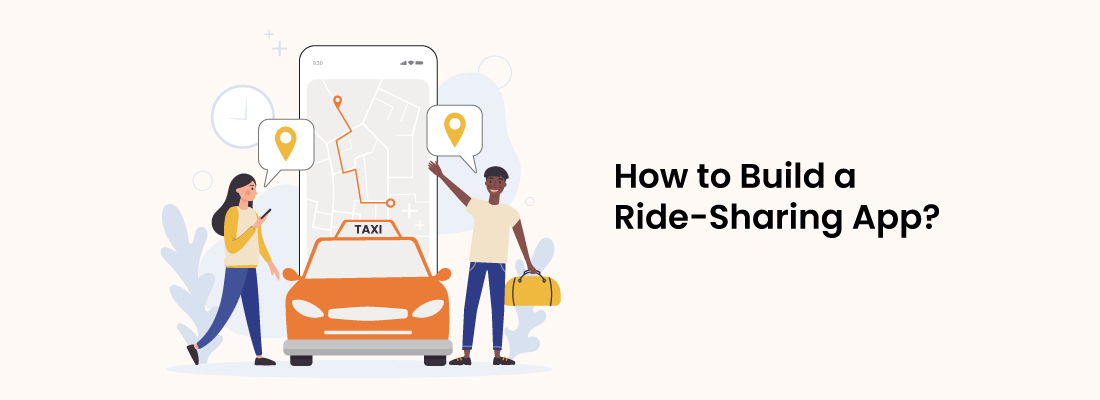Since you are here, it is clear that you have decided to develop your ride-sharing app and join the horde of entrepreneurs who are doing the same to take advantage of this growing market.
It’s also not surprising given that a MarketsandMarkets analysis projects the market value of the global ridesharing apps sector to climb from $85.8 billion in 2021 to $185.1 billion by 2026.

It’s more complicated than it might seem, though, given the large number of strong companies that already dominate the sector, like Uber, Lyft, Grab, and BlaBlaCar, to name a few.
Numerous key stages must be considered to design ridesharing apps that are unique and effective.
These comprise carrying out a strategy plan, choosing important features, completing proper market research, and assessing costs.
Depending on where you hire your on-demand app development firm or certain expertise, the fees change.
Must-Have Features to Create a Rideshare App
A profitable business concept for aspiring entrepreneurs is the expanding on-demand ride-sharing app industry.
Include the characteristics that set it apart from traditional taxi services to compete in the cutthroat market of social commuting.
A ridesharing app’s functions must be separated into versions intended for drivers and passengers, respectively.
Direction, Routing, and Geolocation
Geolocation and routing servers are the actual heroes of prosperous ridesharing apps.
This should be the first and most crucial element of the app when it comes to the creation of carpooling apps.
Entrepreneurs in the transportation sector are in a difficult situation because of the notion that ridesharing apps only rely on GPS.
It is mostly true, yet not totally. It doesn’t reveal the meticulous preparation and math required to determine the precise route and mileage.
They would require a routing server in addition to GPS devices to perform accurate routing and ride-matching procedures.
Account Creation and Profile
After a successful rideshare app development, customer and driver registration and profiles are the two most important elements that help you track the user base.
To expedite and streamline this process, you can allow users and drivers to finish their registrations by email or a social networking site.
You can also ask to be added to their phone number.
For driver profiles specifically, you can ask users to complete the required fields, including a photo, name, and vehicle license number.
To give your app a feature-rich design while still giving it a customer-focused vibe, you may also consider a rating and review system.
Must-Have Features of Ride-sharing Apps for Drivers

There are some features on the driver’s end of the spectrum that you simply cannot do without.
Some of the most fundamental driver-side functions for your ridesharing app are listed in the list below.
Login
The driver will be able to access the app using their credentials thanks to this feature.
Account Profiles
The driver’s name, phone number, license number, location, and frequently traveled routes should all be included in the profile.
Request Accepted or Rejected
The driver will be informed of the traveler’s present location and final destination.
The driver may accept or reject the request for an assignment as they see proper.
Transportation Data
With this, the driver may assess all pertinent trip information, such as the user, the pick-up and drop-off points for other commuters, and the anticipated mileage.
Navigational Integration
The drivers can use this tool to discover the most convenient route to the pickup and drop-off locations.
Based on the actual traffic conditions on potential routes, the optimum route is determined.
Must-Have Features of Ride-sharing Apps for Riders/Passengers
The user experience of a ridesharing app for passengers differs greatly from that of a driver.
Consequently, the following are some fundamental components that your new ridesharing app should have on the rider’s side:
Geolocation
The software automatically generates a route map when the riders choose the pick-up and drop-off locations thanks to its geolocation features.
Account Profiles
Users’ profiles should include information like their names, locations, top routes, and preferred forms of transportation.
Search Filters
Search criteria are important since they help passengers find drivers who are taking the right route.
Riders should also be able to sort offers according to pricing, car type, and even the gender of the driver (for additional safety).
Estimated Cost of a Ride
Riders often find it helpful to have cost estimates based on different routes, vehicle kinds, traffic conditions, and other factors to assist them to choose an option.

FAQs
How long does it take to create a ride-sharing app?
Depending on a variety of variables, including the firm or experts you employ to do the task, developing a workable MVP of a ridesharing app can take anywhere between 3 and 7 months.
What are the various development strategies that can be used for a ride-sharing app?
The first step in developing a ridesharing app is choosing a development strategy.
A ridesharing app can be created in one of three ways: native, cross-platform, or hybrid.
Final thoughts
Yugasa Software Labs, a rapidly expanding on-demand app development firm, takes pleasure in leveraging cutting-edge technologies to construct highly effective apps across a variety of industries.
We take pride in offering our clients services like quick software development that goes above and beyond their expectations.
Based on the thorough information provided above, you can decide which features to include in your ridesharing app and the development path you want to follow.
We can assist you in developing a prototype or minimal viable product that stands out in the lucrative and booming ridesharing market.
Read More: HOW TO BUILD A CHAT APP LIKE DISCORD?
























